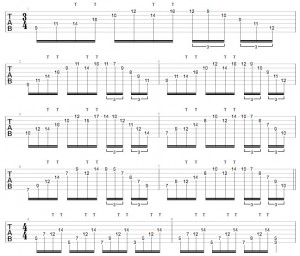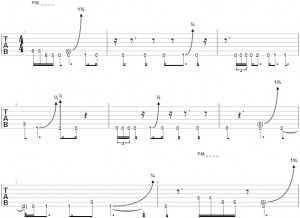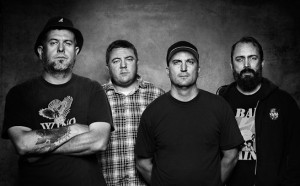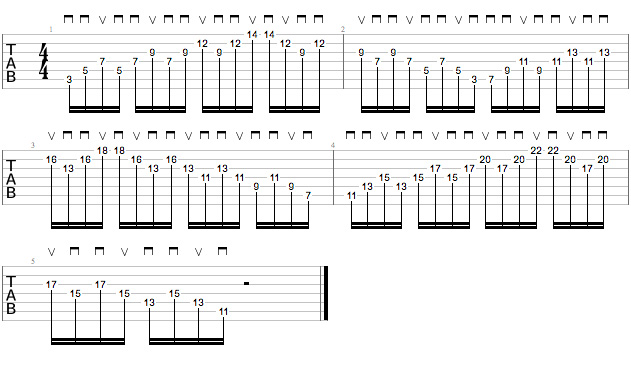Today we’ll discuss the piece of your guitar which many believe has the biggest influence on your sound – one which is a huge deciding factor for many folks when purchasing a new instrument. I am talking of course about the body wood of your guitar. Body wood plays a role in the sound of all guitars, but in this segment I will be speaking specifically about electric solid body guitars.
A lot of players have a general idea of what a particular wood may sound like, but bear in mind that body wood alone is not the biggest factor in the sound of your guitar, because a guitar sound is the sum of its parts. The body of your guitar has different amounts of influence on your tone depending on the way the neck is joined to the body. For the sake of simplicity, we will describe the three most common methods of connecting the neck to the body: bolt-on, set neck, and neck-thru.

A Bolt-on Neck
A bolt-on guitar has the guitar body connected to the neck via metal bolts coming through the body and into the base of the neck. This allows a change of neck or body – in case throwing your guitar off stage into the crowd doesn’t turn out as planned.
A set neck is glued into the body of the guitar so it is permanently attached. Removing a set neck is a much more difficult process than removing a bolt on neck.
A neck-thru guitar is either a guitar made from a single piece of wood, or 2 or more laminated pieces of wood that go from the headstock of the guitar all the way through the body, where wings are then glued to the sides and completes the shape of the body. To repair a broken neck-thru guitar requires a lot of skill and experience.
When deciding what sounds you want from your guitar, you should know how much each part of the guitar contributes to the total tone of the instrument. It is important to know exactly what you are looking for in terms of sound. Making these decisions will make a big difference in your gear selection. I have come up with some rough percentages as to what a body will contribute to your sound:
For a bolt-on body such as a Tele or a Strat, the body accounts for about 25% of the total sound. That may seem low to most, but remember there are many other factors changing the sound of your axe. The body of a set neck style guitar such as a Les Paul or an Explorer will account for about 30-35% of the tone. The wings of a neck-thru guitar, which give the body its shape, contribute about 10-15% of the tone.
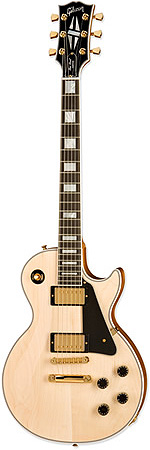
Gibson Les Paul w/ Mahogany body wood
Keeping that in mind, here are some basic body woods and what they sound like:
Alder (Alnus Rubra)
The original Strat tone! Popular among many of our favorite players from SRV to Eric Johnson to Yngwie Malmsteen. Very even across the board, Alder does not particularly accentuate any specific area of the tonal spectrum. Equal in highs, mids, and lows, this wood is great for all genres of music. Works great for blues/rock, jazz, country, and even metal. Medium in weight and very durable.
Ash (Fraxinus Americana)
This wood is most common in old 50’s Strats and country Teles. Most common varieties are Northern Hard Ash which is very heavy and has great sustain, and a very bright tone popular with the chickin’ pickin’ crowd or anyone with a really dark amplifier. The other variety is Southern Swamp Ash which is much lighter. This variety has a very tight bass and a spectacular sparkle in the upper mids and highs as well as a midrange drop out making it a great Strat wood for getting that scooped funk tone.
Mahogany (Khaya Ivorensis)
Most common in Les Pauls, SGs and just about every other G-brand guitar. Noted for its great thick sound with a huge low end, a very sweet high end and a bold presence in the mids, making it great for leads and low down blues as well as some heavy metal sounds. It can get muddy from having so much bass, so be careful when choosing your pickups and top wood. Adding a Maple top will clear up the bass and give it crisper highs. Mahogany with a Maple top is one of the most common configurations on guitars today.
Basswood (Tilia Americana)
Great for bad backs! This wood is very light, but also very soft. Very nice all around sound that is built for a great shred tone. Basswood is very clear in the mix when playing live, but can cave in and have a mushy bass. Works best with a Maple top. Some builders think that Basswood with a Maple top is the holy grail of guitar sounds.

Fender Koa Telecaster
Poplar (Liriodendron Tulipifera)
Almost equivalent in all ways to Alder except in the weight division and a bit more snap. Poplar is a great tone wood that is overlooked by many builders because of its lower cost. Parker Guitars has been using it for their Fly Deluxe models for years.
Now for some more exotic varieties….
Walnut (Juglans Nigra)
Frequently used as a top wood on some exotic boutique guitars, but works great as a body wood. Provides very tight bass and bright highs, and has a killer presence that always cuts through and sounds clear. Walnut is very heavy, but always aesthetically pleasing.
Koa (Acacia Koa)
Very similar to Mahogany except with a clearer treble range. Very rare as it is only grown in Hawaii. Sounds phenomenal with any pickup choice and has a medium/heavy weight. One of the best looking woods with its blonde/brown waving features. A knockout with humbuckers.
Korina/Limba (Terminalia Superba)
Think of Mahogany and Maple sewn together. It has the great thick sounds of Mahogany without the looseness in the bass, and a more present upper midrange that really sings. Provides a very quick attack, and works well with all sorts of pickups. Comes in 2 different varieties, black/striped, or white. Looks great with a natural finish, and was used on some of the more wild G-Brand guitars back in the day. Regaining popularity, but still relatively unknown. Not a great choice if you are looking for a true Strat or Tele tone.
There are a handful of other tone woods that are great for guitars, and will also make great top woods. Among these are Zebrawood, Bubinga, Wenge, Lacewood, Rosewoods, Spruce, Redwood, Padouk, and all sorts of Maples. Most of them will give a brighter top end or have a neutral affect on tone and are mostly for looks.
Also common with a lot of builders is a technique called chambering. This is when you take a guitar with a top wood and carve out some of the wood on the inside of the body. This in essence makes it a hollowbody without any sound holes. This will reduce some of the bass in a guitar, but will make it feel more open and airy. Great for jazz players and indie guys looking for a very organic tone.
With all of this knowledge, you can now confidently walk into a music shop and know what you want to play off of the rack. Here are some very popular combinations you may want to look for depending on the style you play:
Jazz – Chambered Mahogany body with a Maple top and low output humbuckers or P90’s
Blues/Classic Rock – Alder/Ash with low/medium output single coils, Mahogany/Mahogany with a Maple top and low output humbuckers or P90’s
Funk – Ash/Poplar body and single coils/lipstick tubes/Filtertrons
Hard Rock – Mahogany/Mahogany w/Maple top & medium/high output humbuckers
Metal – Alder, Basswood, Basswood w/ Maple, Mahogany w/ Maple with medium/high output humbuckers or single coils
Here are some personal favorites of mine that you may want to try out as well:
Solid Koa w/ humbuckers – All styles
Chambered Korina w/ P90s – All styles but Metal
Solid Korina w/ humbuckers – All styles but Funk
Solid or Chambered Walnut w/ low output pickups – All styles
Basswood/Maple W/ HSS configuration – All styles
Alder/Maple W/ humbuckers – Original PRS Tone
Chambered Ash W/ any pickups – Indie Rock
I hope this helps all you gear heads out there in guitar land, and will give you something to ponder when selecting your next weapon of choice. Remember that the body is an important part of your tone, but as I said before not the most important part of your guitar’s total sound – the most important being the neck. Yes, you heard right, the neck is the biggest contributing factor to your guitar’s tone. So when you stroll into your local music shop, remember that the body wood is important, but not as important as the neck. And that will be our topic for next time, so stay tuned!



